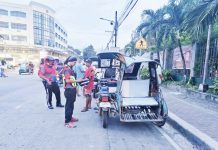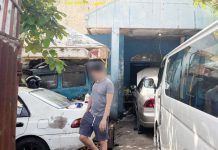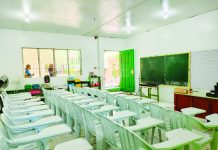
I HAVEN’T been to museums lately. My feelings are somewhat ambivalent. I miss it and don’t miss it at the same time. Is that ironic? I’m sure someone will connect the dots, haha!
For now, let’s tackle the National Museum Bohol. I grew up mounting the stairs of the old provincial capitol building which is presently the site of National Museum Bohol. I also vividly recall seeing prisoners each time I climbed the staircase to visit my father who was then serving the leadership of former Governor Lino I. Chatto, later as Secretary of the Provincial Board, and eventually as Boardmember of the province of Bohol. I would say I have an affinity with the building, and the flight of stairs! Someone ought to know about this!
According to the Bohol Museum website, the provincial capitol building was built from “1855 to 1860 to serve as a tribunal, prison, and military quarters for the Spanish military force.” If you pass by the building, look up, it’s plastered on the entrance.
Like any old structure in Bohol, the building is replete with historical facts and tidbits making it worthwhile to write about. Add to that, I’m a Boholana so anything Bol-anon merits my time. No argument there, haha!
Now, let me bring you back to 1852 when the proposal to build the structure began. Reportedly, the Spanish forces then were under the military and political governor of Bohol, Captain Guillermo Kirkpatrich. At the time, Spanish authorities deemed it right to construct the “headquarters in Tagbilaran . . . because of its good harbor.” That sound decision made centuries back proved useful up to present times!
Two years after, on December 15, 1854, an agreement was inked between Don Leon Torralba and Kirkpatrich to initiate construction of Plaza del Principe. Torralba was then gobernadorcillo (mayor) of Tagbilaran while Kirkpatrich, aside from being a military top brass, was also an engineer, museum website offered.
Like any Spanish construction in that era, stone and lime were used and based on historical records, “the builders used 27,300 bricks, 4,325 cavans of lime, 61,000 roofing tiles, etc.” Museum website added, “Most of the beams and girders were of “banaba” wood. Molave or tugas was used in the prison cell. The flooring was made of “bangkal” wood.” No wonder the building had withstood the best and worst of times.
Moving forward to 1860 and under the administration of gobernadorcillo Esteban Butalid – 1856-1860, a wealthy man, the completion of the huge structure was facilitated through his financial aid.
Present times
The old provincial capitol underwent many repairs and renovations over time and aptly, historical research was done to ensure that renovation works were properly guided. I couldn’t agree more.
This historic Provincial Capitol of Bohol served the local government unit and the Boholano constituency until October 15, 2013, when a 7.2 magnitude earthquake wreaked havoc on the province. The building was donated to the National Museum of the Philippines (NMP) by the provincial government of Bohol on June 16, 2014. Hmm I was in General Santos City in 2014.
Repairs and restoration were done and when it finally opened on July 22, 2018, voila! it reopened as the National Museum Bohol! Talk about evolution! I had explored the museum in January 2019 before the darn pandemic hit the world.
As a sentimental soul with affinity for the building, having ascended and descended the staircase countless times in my young life, it is an understatement to say the building is priceless. It has seen the growth and decay; the losses and gains of the people including the Bol-anon’s brand of traditional politics; the rapid and slow development; and the evolution of the province. In sum, it had seen the love story of the province much like my love story.
When Papa was first sworn in as Provincial Boardmember of Bohol, the backdrop of the stage was the balcony facing the Plaza. We have a photo of that in the house. When the canvassing was done when Papa nearly missed the 10th slot as provincial boardmember, the counting was done at the then Session Hall of the Sangguniang Panlalawigan. Memories, memories. Writing about it just opens the floodgates of memories safely locked in my inner chamber for years.
On July 22, 2012, the provincial capitol building was declared an Important Cultural Property by the NMP and rightly so.
For more information about National Museum Bohol, visit nationalmuseum.gov.ph/our-museums/regional-area-and-site-museums/bohol/.
***
Writer hosts Woman Talk with Belinda Sales at 91.1 Balita FM Tagbilaran City every Saturday, 4 p.m. to 5 p.m. She can be reached at belindabelsales@gmail.com. Twitter @ShilohRuthie/PN





